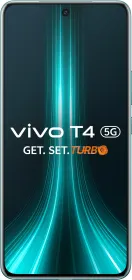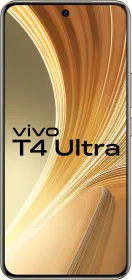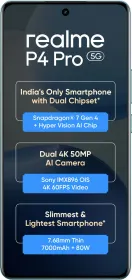When you first pull Meta’s new Ray-Ban glasses out of the box, they don’t scream “future gadget.” They look like… Ray-Bans. And that’s precisely the point. For the first time, smart glasses don’t feel like a science project.
But we’ve been here before. From Google Glass to Snap Spectacles, the road to smart glasses is littered with devices that were technically impressive but practically unusable. They stumbled on the same fundamental problems: terrible battery life, bulky designs, and a vibe that screamed “don’t sit next to me on the train.”
So what’s different this time? The real breakthrough is the invisible engine hidden inside: Qualcomm’s Snapdragon AR1 Gen 1 chip. Instead of trying to cram a smartphone onto your face, Meta and Qualcomm went small and efficient. And it changes everything.
Ray-Ban Meta Smart Glasses Price & Availability
The Ray-Ban Meta smart glasses are officially available for purchase in India through the Ray-Ban India website and select retail stores. Pricing starts at ₹32,990 for the standard Wayfarer and Headliner styles with various lens options. Transitional or polarized lenses cost slightly more. This official availability is a huge plus, as it means local warranty and support are available without the need to import the device.
Pros
- Familiar Ray-Ban design
- Surprisingly solid photo and video quality
- Intuitive controls and a well-designed charging case
- Clear calls and convenient open-ear audio.
- Officially available in India with local support
Cons
- 3-hour battery life is a major limitation.
- Frames can loosen and can’t be easily adjusted
- AI assistant is useful but has clear limitations
- A slippery fit can be an issue in hot, humid climates
Ray-ban Meta Glasses Review: Setup and Daily Use

When you open the box, there’s no futuristic fanfare. Just a familiar Ray-Ban case, except it’s also your battery pack. Slim, portable, and discreet, this case is your lifeline, charging the glasses on the go and providing multiple recharges.



The setup process is straightforward and handled entirely through the Meta View app on your smartphone.
- First, you download the app and sign in with your Meta account.
- Next, you put the glasses into pairing mode with a long press of a button inside the case.
- The app discovers the glasses via Bluetooth, and you’re guided through a quick tutorial on the controls, privacy features, and how to grant necessary permissions for things like Wi-Fi syncing and access to your contacts.
Once set up, using the glasses becomes second nature. The controls are simple and intuitive:


- Take a Photo: A single press of the capture button on the top-right frame. You hear a shutter sound in your ear.
- Record a Video: Press and hold the same capture button to start recording (up to 180 seconds). A second press stops it.
- Control Music & Calls: The side of the right temple is a touchpad. Tap to play/pause music or answer a call. Swipe forward to turn up the volume and backward to turn it down.
- Activate AI: Simply say, “Hey Meta,” followed by your command.
Ray-ban Meta Glasses Review: Design and Build
At first glance, you’d be forgiven for thinking these are just regular Ray-Bans. The design stays true to the iconic Wayfarer silhouette, with only slightly thicker temples betraying the tech hidden inside. They’re a touch heavier than standard frames, but not distractingly so, you can wear them for hours without that telltale “tech fatigue” you get from bulkier headsets or AR glasses.

The charging case is arguably one of the smartest design decisions. Unlike a traditional sunglass case, this one doubles as a portable charger, slipping into a sling or backpack and giving the glasses multiple top-ups throughout the day. You’ll rely on it often, since the glasses themselves top out at 3–4 hours of continuous use. Without the case, these aren’t an all-day device; with it, they’re at least practical for a full outing.
Controls are simple and intuitive: a touchpad on the right temple handles playback and volume gestures, a capture button on the top-right edge snaps photos or records videos, and a power toggle sits on the left side. The learning curve is practically zero. It feels like these could be a natural extension of the sunglasses you already wear.
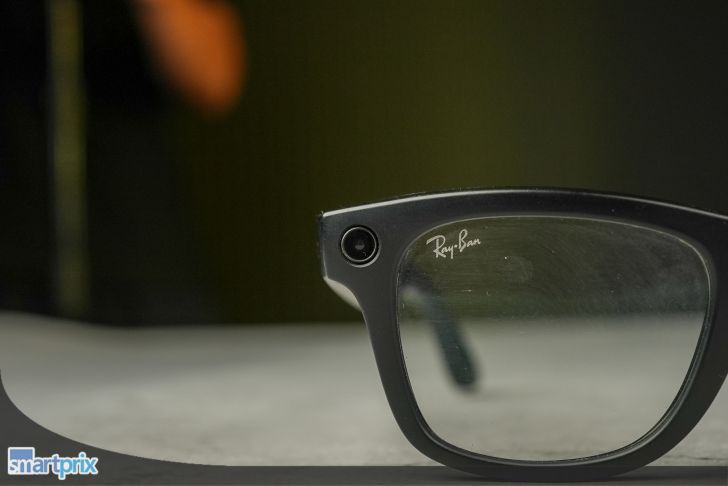
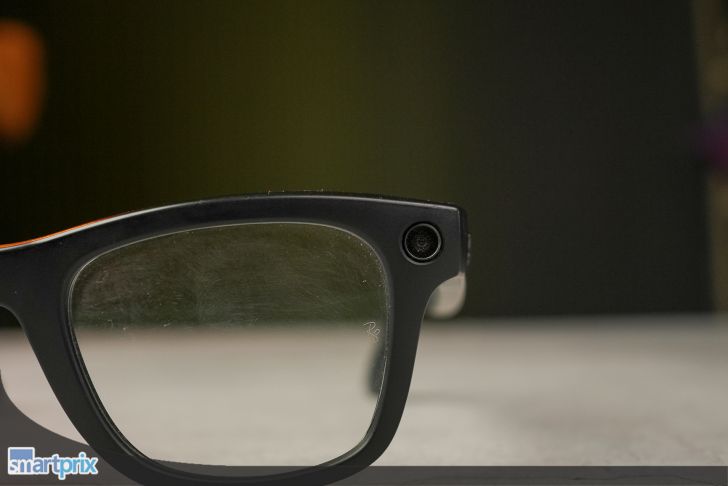
Meta has also leaned into privacy signaling. A Capture LED blinks whenever a photo is taken and glows steadily while recording video. It’s a small but important gesture, making sure people know when the glasses are active, something earlier wearable experiments like Google Glass failed to get right.
But here’s where reality bites. While the frames are comfortable out of the box, they’re not immune to wear and tear. Over time, the temples can loosen, and unlike regular Ray-Bans, these can’t be easily tightened by a local optician. Ray-Ban’s own support has confirmed this is a limitation.
And then there’s the issue of heat and humidity. In Indian conditions, the silicone nose grips become slippery after a while, forcing you to constantly nudge them back up your face. It’s a small annoyance that adds up, especially if you’re out for hours in the sun.
Ray-ban Meta Glasses Review: Hardware and What’s Inside
The discreet design and all-day wearability are only possible because of what’s hidden in the thickened temples: Qualcomm’s Snapdragon AR1 Gen 1 chip. Unlike the processors crammed into phones or VR headsets, the AR1 isn’t built for brute force; it’s built for efficiency. And that focus makes all the difference.
The chip’s dual Image Signal Processors (ISPs) handle the 12MP ultra-wide camera intelligently, balancing colours, sharpening details, and cutting down on noise before the image ever reaches the storage. Photos don’t rival what your flagship phone can do, but they’re consistently clear, vibrant, and ready for Instagram without endless tweaking.
Audio gets the same thoughtful treatment. A dedicated ultra-low-power audio engine ensures that listening to an hour-long podcast or streaming music on your commute doesn’t tank your battery. You start to notice that you’re using these glasses like a casual audio device and not constantly checking your phone’s battery widget in the process.
And then there’s the heat question. Anyone who’s used early AR or VR headsets knows the telltale warm forehead that comes from processors running too hot. Here, that’s not an issue. Even after back-to-back video recordings, the Ray-Bans stay cool to the touch, a small but crucial detail that makes them genuinely wearable in everyday life.
Specs aside, what’s it actually like to wear these day-to-day?
Ray-ban Meta Glasses Review: Camera Performance
The 12-megapixel ultra-wide camera on the Ray-Ban Meta glasses isn’t built to dethrone your iPhone or Pixel, but that’s not really the point. What it does is give you the freedom to capture moments exactly as you see them without pulling out a phone. A quick tap on the capture button or a casual, “Hey Meta, take a picture,” is all it takes. You hear a subtle shutter sound in your ear, and the memory is locked in.









I tested them across three very different settings, and the results were surprisingly consistent. In Phuket, I wore them on the cruise ride, where I took photos in good light and low light that would normally ruin a phone shot. The glasses managed to capture enough detail to make the memory feel alive, grainy, yes, but atmospheric. Later, on a boat ride off the coast, the camera really showed its strengths: wide, sweeping shots of the turquoise water and the horizon that looked instantly Instagram-ready. What struck me wasn’t the resolution (3024×4032 stills, 1440×1920 video) but the perspective; it feels different when the camera is literally your eyes.
Then there was the India–Pakistan Asia Cup match in Dubai, where no phone could have given me the option to record the stands from my POV. With the glasses, I didn’t have to choose between cheering and filming. A 60-second clip of the crowd erupting after a wicket felt raw and immersive, like I’d bottled the sound and energy of the stadium. This is where video shines: it’s limited to three-minute clips, but those are perfectly cut for social media. Stabilization is better than you’d expect from something this tiny, and while you won’t be replacing a GoPro, it delivers exactly what it promises: your perspective, hands-free.
In bright daylight, photos are vibrant and punchy enough for social media; however, as the moment’s lighting dips even slightly, you notice noise creeping in. Still, the real magic isn’t about pixel-peeping. It’s about recording life as you live it, without a screen between you and the experience. Whether it was the eerie glow of a Phuket ride, the calm of the Andaman Sea, or the roar of Dubai cricket fans, the Ray-Ban Meta glasses made me feel present, and that’s worth more than megapixels.
Ray-ban Meta Glasses Review: Mic and Audio
I’ll admit, I was skeptical about the open-ear speaker setup. Most glasses with built-in audio end up sounding tinny and leaking sound to everyone around you. But after a few weeks of living with the Ray-Ban Meta glasses, I found myself consistently leaving my TWS earbuds at home, something I didn’t expect at all.
The magic lies in how the glasses create a personal sound bubble. Walking through Dubai after the Asia Cup match, I replayed clips and scrolled through voice notes. Even with honks and crowd noise around me, I could hear everything clearly while still staying aware of my surroundings. That’s what these open-ear speakers do best: they’re not about booming bass, they’re about convenience without isolation.
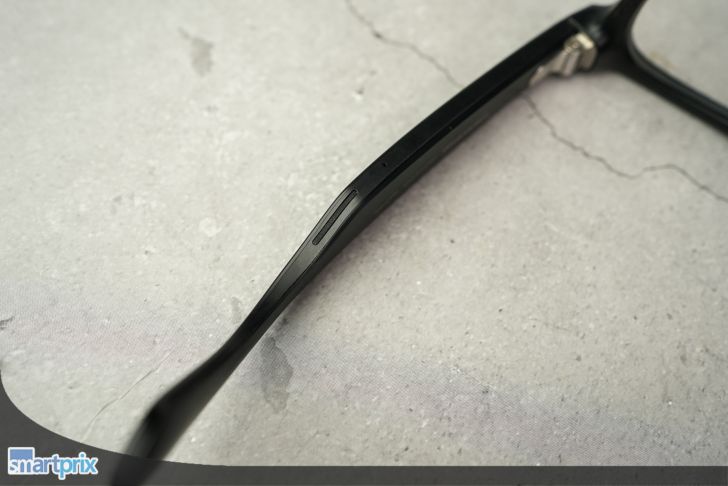
Call quality is where Meta and Qualcomm’s engineering really shines. The five-microphone array, combined with the Snapdragon AR1 chip, does an almost eerie job of isolating your voice from the chaos. I tested this in Phuket’s night market, where hawkers were yelling over sizzling woks, yet my friend on the other end said I sounded as if I’d stepped into a quiet room. That’s the Snapdragon silicon working in the background, handling voice isolation, filtering out background noise, and making sure you don’t sound like a muffled mess.
For music, the experience is decent but limited. Vocals and podcasts come through crisp, but the bass is virtually absent. During a late-night walk on the beach in Phuket, I played some lo-fi tracks. Instead of immersion, what I got was a soft, almost ambient layer of sound mixing with the waves. It wasn’t hi-fi, but it was intimate and in some ways, more natural.
Ray-ban Meta Glasses Review: Meta AI
Using Meta’s AI assistant feels like interacting with a beta product, but one with moments of pure magic. You activate it with “Hey Meta,” and its usefulness shines in specific, hands-free scenarios.
Riding my bike through town, I wanted to let my family know I was on my way. Instead of stopping and fumbling for my phone, I just said, “Hey Meta, send a WhatsApp to Mom saying I’ll be home in 10 minutes.” A confirmation tone played in my ear, and the message was sent. That kind of seamless convenience feels genuinely futuristic.
It’s also surprisingly capable with translations. While at the local market with my hands full, asking “Hey Meta, how do you say ‘How much is this?’ in Hindi?” gave an instant, clear translation of यह कितने का है?
However, it has clear limits. I tried asking more complex local queries like, “Find the best chaat stall in Noida.” The assistant simply defaulted to reading a generic web search result aloud, which wasn’t helpful. It’s a powerful tool for simple commands, messaging, calls, quick facts, and translations, but it isn’t a deeply aware local guide just yet.
Ray-ban Meta Glasses Review: Battery life
Here’s where the fantasy of truly wearable smart glasses begins to falter: battery life. Meta promises about three hours of continuous use, and in my experience, that’s exactly what you get, no more, no less.
That number sounds decent on paper, but in practice, it means you’re constantly doing mental math: Do I have enough juice left for one more video? Will it last until I get home? At a concert or during a long cricket match, the warning chime in your ear comes far too soon. The magic of hands-free capture fades quickly when the glasses demand a break before you do.
The bigger problem is logistics. If you wear prescription lenses, every recharge cycle forces a clumsy swap: Ray-Bans go into their chunky charging case, prescription glasses come out. You end up carrying two pairs of eyewear just to survive a single day. That’s not exactly the seamless future Meta is selling.
Even during lighter use, snapping occasional photos on a walk, listening to a podcast on the metro, or taking calls on the move, the glasses rarely stretched past half a day. The Snapdragon AR1 chip deserves credit for squeezing efficiency out of such a slim frame, but physics still wins. There’s simply not enough room in a stylish Ray-Ban shell for an all-day battery.
If you treat these as short-session devices, they’re brilliant, perfect for a coffee run, a walk through the park, or a quick errand. But as something you can rely on from morning to night? Not yet. And that gap between promise and reality is the single biggest thing holding the Ray-Ban Metas back from feeling like a true everyday essential.
Frequently Asked Questions (FAQ)
Can you use the Ray-Ban Meta glasses without a phone?
You need a phone for setup and to sync media. However, you can take photos and videos without a live connection; they will sync later. Music, calls, and AI features require a Bluetooth connection.
Are the Ray-Ban Meta glasses waterproof?
They are rated IPX4, which means they are water-resistant against splashes but not submersible.
Review Verdict: Should You Buy the Ray-Ban Meta Glasses?
Meta will sell you on the AI, the camera, or the stylish branding. But the real genius here is invisible: Qualcomm’s Snapdragon AR1 chip. It’s the hero that makes the design possible, the AI functional, and the entire product practical.
The downsides are real limited battery life and a slippery fit in hot climates are significant hurdles. But compared to the graveyard of failed smart glasses, and with official availability in India, these feel like tangible progress. For once, smart glasses don’t feel like a gimmick. They feel like a beginning.

Smartprix ⭐ Rating: 8/10
- Design & Comfort: 8/10
- Camera & Video Quality: 7.5/10
- Audio Performance :8.5/10
- AI & Smart Features: 8/10
- Privacy & Social Acceptance: 9/10
- Hardware & Performance: 9/10
- Everyday Usability: 7.5/10
- Battery Life & Charging: 6.5/10
First reviewed in October 2025.


















